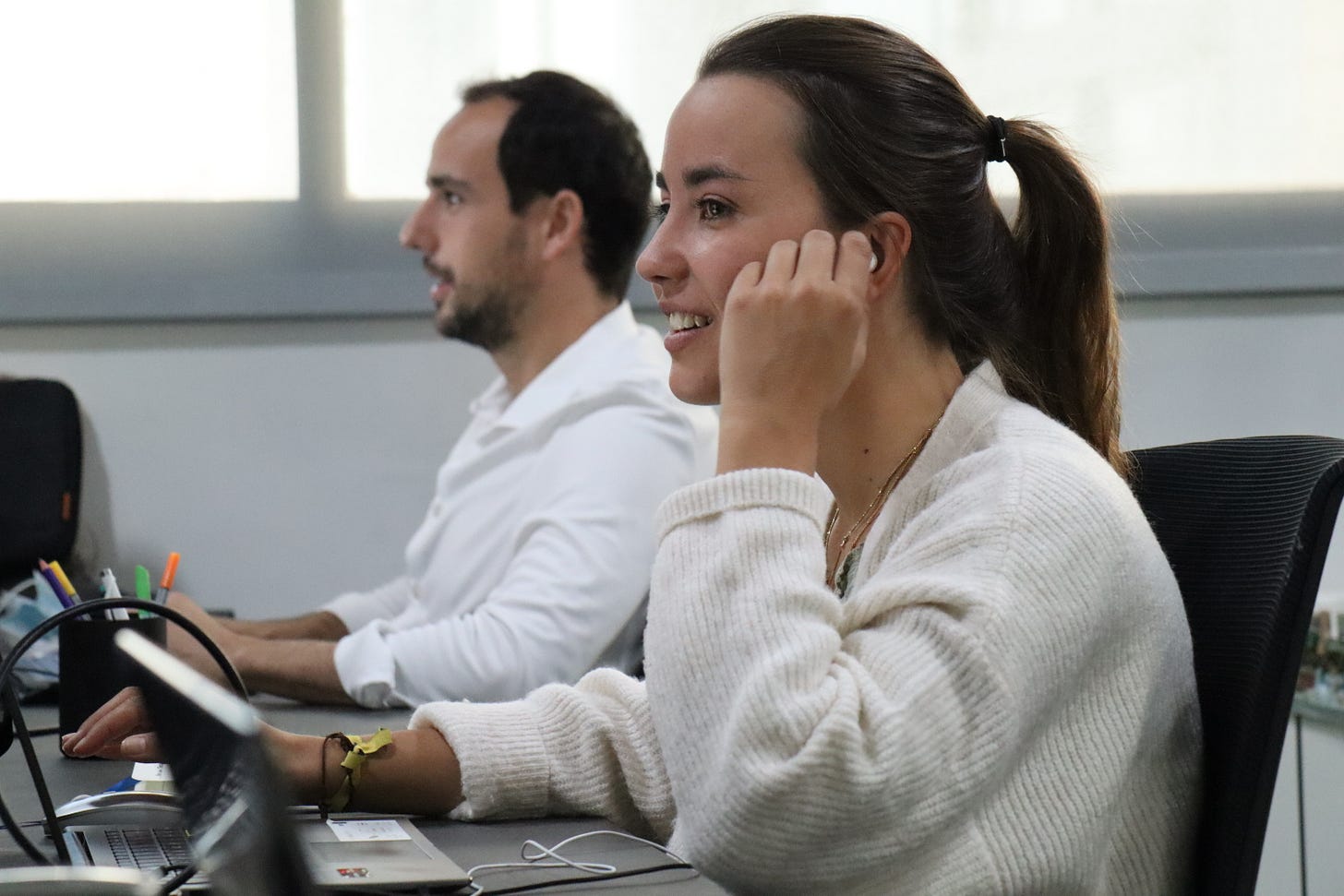Hey, we are Ramón Rodrigáñez and Andrea Marino, Co-Founders at Nova, the Global Top Talent Network.
Welcome to Talent First, our newsletter where those who believe that talent is the most important resource in the economy get together.
Every week we cover a new topic related to attracting, hiring, developing, and retaining talent, as well as the learnings from our journey building Nova.
Summary:
The power of feedback in team performance.
Some lessons learned while building a feedback culture and how we differentiate between individual and group feedback.
Why is feedback so important yet so hard to embed in a company culture?
In the early days at Nova, when a handful of people were working together, feedback came naturally as founders we were not intimidated by each other and our early employees grew up experiencing a much more fluid feedback dynamic where every day we had to revisit assumptions, made mistakes and had to change direction. However, as the team grows and multiple hierarchical levels are created, as founders it’s easy to forget that newly joined individual contributors don’t have the same confidence as more seasoned employees to give feedback, especially upwards.
We know that feedback resistance is human and it’s rooted in our evolution and some basic cognitive mechanisms we cannot change. The fear of rejection is hard to control, as tribal species acceptance has been critical for survival and our brain has not yet adjusted to a modern society where negative feedback is not a threat to our safety. On top of evolutionary reasons, we have experienced firsthand how different societies (Sweden vs South Europe) approach feedback and communication differently so the cultural factors also play a role when shaping the company culture.
When we realized that feedback was not flowing equally upward and downward we decided to take clear action and make sure feedback could become a key part of our company going forward. Not because we want to contribute to the human brain evolution but because feedback is proven to accelerate performance and engagement significantly.
What makes investing in a feedback culture important?
There is a lot of research on the interplay between feedback and performance, with clear evidence of the positive correlation. On average, employees are three times more engaged when they receive daily feedback from their managers compared to only annual feedback and are 87% less likely to leave their roles. These key figures alone should explain why any company, big or small, should work on a feedback culture that is not only living on annual formal reviews that very often feel forced and where people are never as transparent as they’d like to be.
How did we start the feedback culture at Nova? Strong principles and clear guidance.
We started with our company principles
Since the early days, we had *Principle 4 “Hire and Develop Only Nova Talents: We hire exceptionally talented individuals and are committed to their growth through continuous feedback”*. This was a loud signal to current and future employees about our normalization of constant and open feedback.
Create a safe space and clear infrastructure
At Nova, we conduct structured feedback sessions every six months, complemented by ongoing informal feedback. The structural feedback that happens twice a year has been instrumental in making sure feedback started to be accepted at all levels. By giving detailed instructions on how to hold a feedback session and keep everyone accountable to organize and run their feedback session, people removed (partially) the fear of giving feedback to each other and started to view it more as a gift and a tool for contributing to people growth and raised self-awareness.
Give very detailed instructions and prepare people for their first session
As we had employees with different seniorities, we made sure the playing field was clarified for all people. This is why we prepared a detailed employee manual which is too long to share here but some inspiration can be found in the following bullets:
At Nova, we give feedback to improve how we work and how we communicate. That is why, when giving feedback we base ourselves on the following principles:
We do not forget about the good things. It is important to tell them.
However, we do focus on the “not-so-good” things because those are the things that matter.
We are always constructive about the bad things and suggest ways of improvement.
We give concrete examples of what was done wrong.
If it affects the relationship or is something more behavioral, we explain how we feel when the other person does it. For instance “I feel pressured when you ask me things over Slack 3 times. I would be grateful if you had a bit more patience and could wait for me to answer”.
We are radically transparent and we search for the truth. That is why we never “let go” of things just because they are unpleasant or we believe they may make the other person feel bad.
We try to come up with strategies on how the person receiving feedback can improve.
We are empathetic with the person put ourselves in their shoes and make the best effort to see their perspective.
While these can appear as the usual nice words, having a shared set of rules makes it easier for people to open up as it is not only required but also normalized.
Turning the formal feedback sessions into a day-to-day norm
The formal feedback sessions are a great starting point, however, feedback has a stronger impact as it becomes a continuous norm. The challenge to crack here is how you normalize unpleasant feedback and how you decide between giving feedback in front of a larger group versus individually.
Reflecting, at Nova we managed to progress significantly thanks to both top-down and bottom-up mechanisms.
From a top-down perspective, we had to go with the easiest and strongest “lead-by-example approach”. This meant, in company-wide meetings, giving open feedback to other managers in front of the rest of the company. We often doubted when certain feedback was best shared individually versus in front of the group.
The general rule we have developed as founders is to share in front of other people:
General praise or recognition (easiest to give)
Recognize achievements, teamwork, or good practices that benefit the group.
Example: "The way Sarah led the last project was a great example of collaboration and efficiency.”
Shared lessons or constructive ideas:
Feedback that benefits everyone and fosters learning.
Example: "We noticed that projects are more efficient when deadlines are clarified early. Let’s all adopt this habit moving forward."
Process improvements:
Suggestions related to workflows, systems, or group dynamics.
Example: "Our meetings tend to run long. Could we experiment with shorter check-ins?"
Group accountability:
Address issues affecting everyone equally, like missed team goals or significant delays.
Example: "Let’s revisit how we divide responsibilities to ensure everyone is aligned."
The feedback we keep for one-on-one is often the most critical and the ones that touch upon identity items:
Behavior feedback:
Critiques about specific performance, behavior, or personal habits.
Example: "Your recent report had some inaccuracies and lack of detail orientation; let’s review it together to ensure clarity."
Feedback that could cause embarrassment:
Anything that could damage confidence or create discomfort.
Example: "I noticed some delays in your tasks last week; is there anything blocking you?"
Complex or emotional topics:
Issues involving emotions, conflicts, or personal challenges.
Example: "I’ve observed some tension in your interactions with X. Can we discuss how to address it?"
Feedback needing detailed discussion:
When context, nuance, or solutions require focused time.
Example: "I’d like to go over your current performance and how it aligns with your professional development goals."
One-off Issues:
Problems unique to one person, not relevant to others.
Example: "Your approach in the last presentation could benefit from a stronger opening statement."
From the bottom-up perspective, we proudly stole from our tech team some of their retrospective dynamics, the “Sailing boat” being our favorite, to host sessions with the teams where we incentivize constructive conversations and feedback to not only processes but also managers. While during those sessions the more individual feedback does not surface as much, they still serve to show that managers are willing to listen and are open to accepting clear feedback, we hope that those seeds will incentivize a strong feedback flow upwards too. While as founders we still receive less feedback than we know we need and deserve, we see strong signs of progress.
While creating an organization built on constant feedback might seem tricky and expensive, it’s all about making people normalize it via a mix of clear organizational rules, detailed individual instructions, and strong leadership examples.
Thanks for reading Talent First. If you liked this issue, don't forget to hit ❤️. This is our last edition for this year so we take the chance to wish you all Happy Holidays, we hope you’ll take some time off to recharge the batteries, reflect on a great year ahead and maybe get some inspiration from our previous TF editions (just kidding…or maybe not 😛)
We would be grateful if you could share it by email or social media with other people who might like it or might be looking to hire top talent.









